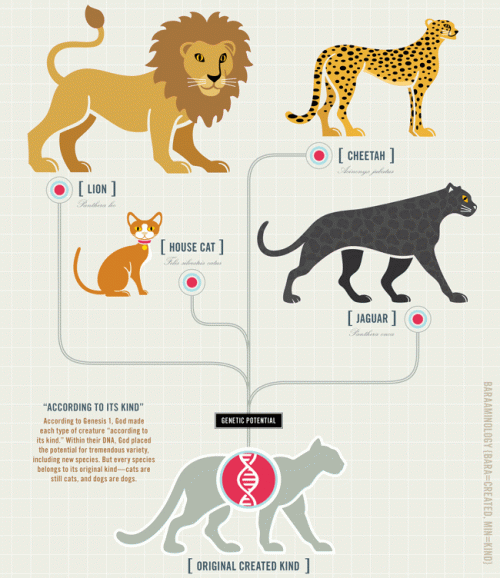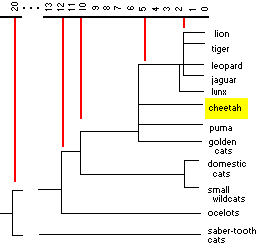I visited both the Creation “Museum” and the Ark Park, and one thing that leapt off the displays to me, and to other biologists I’ve shown these things to, is that Ken Ham has evolved to become a kind of hyper-evolutionist. Take a look at this illustration from Answers in Genesis, for instance.
Now compare it to this diagram of cat evolution.
Not that different, are they? They’re both tree diagrams, they both show an ancestral form diverging into multiple modern species, they both imply change and evolution. AiG’s is more cartoony and simplified, the real evolutionary diagram has more species, but the differences are more of style than substance, except for one little thing.
The time scale on the evolution image is 20 million years.
The time scale on the AiG image is 4 thousand years.
It’s weird. Answers in Genesis has gradually gone from complete denial of any evolution at all to arguing for so much evolution so fast that it’s enough to make a population geneticist choke. Does his audience care? I guess not. They’re not used to recognizing the implications in a quantitative chart, I guess, and see no conflict at all in ol’ Ken Ham waving his hands at a phylogram on steroids while claiming evolution is false.
Naturalis Historia has a more detailed discussion of this phenomenon, with a very nice wrap-up.
Would you recognize many of the animals that boarded Noah’s Ark? Not according to Ken Ham and his colleagues. The ark contained only the common ancestors to the great diversity of animals you see today. Giraffes on the ark? No. Chimpanzees? No. Lions? No. etc… One cat pair evolved into more than 100 species of cats most of which went extinct just a few hundred years after the Flood. Yes, Ken Ham has fully embraced Post-Flood Rapid Evolution as a mechanism of creating the amazing variation we see today. As he falls further down the slippery slope into the rabbit hole of radical hyper-evolution Ken Ham is, ironically, more accepting of naturalistic speciation (Darwinian evolution) than Old Earth advocates such as Hugh Ross.




I disagree. What Ham advocates is not hyper-evolution. It’s hyper front-loading.
“AiG’s is more cartoony and simplified…”
Christians place great emphasis on simplification, as their child-like minds are unable to comprehend anything complicated. That approach eliminates things like fact, evidence and truth, but it does make everything easier to understand. Besides, in Mark 10:15 Jesus says “Truly I tell you, anyone who will not receive the kingdom of God like a little child will never enter it.” Christians take that quite literally.
Those original created ‘kinds’ (‘kinds’ not the individual species known to biology) are fiction – an invention dreamed up by ‘biblical’ creationists who are misreading Genesis where it says (in English) ‘according to their kinds’ or something similar. It’s certainly not science. That Nathaniel Jeanson book uses the same unscientific presupposition about original ‘kinds’ and invents something else (he claims his ideas are testable) – ‘created heterozygosity’. Also, there’s nothing about speciation in the Bible. Just multiplication post-flood – from the pairs disembarking (which were meant to represent every single land animal not some ‘prototype’ for later species).
Re the above comment, I’ve seen Jeanson use that ‘front-loading’ phrase too.
The difference is that under the creationist model there was Platonic-ideal of a cat that was poofed into existence 6000 years ago who’s descendants changed not due to generations of mutation and natural selection, but because they were “corrupted” by humanity’s sins.
So, really, it’s not the same at all. It’s just plain wrong.
There’s also the matter of what those trees say about likely genetic similarity, based on time of divergence. By the AiG diagram cheetas are more closely related to house cats than jaguars and lions, which diverged from each other before house cats or cheetas diverged. Everything about that is wrong.
“Front-loading” is merely the nonsensical, indefensible phrase they use to explain how their hyper-evolution could occur.
#7 Of course it is non-sensical and indefensible. It is even more nonsensical and indefensible than if they actually advocated hyper-evolution.
Most.punctuated.equilibrium.evar.
As long as they believe in “kinds”, they won’t care. Because the supposed metaphysical barrier between different “kinds” ensures that even hyper-evolution couldn’t account for the diversity of life.
I think it actually would be fun to try and classify every animal we see today with Hamolution. Cat-type and dog-type species are easy of course. But what about the weird stuff, like the platypus? Would Hamolutionary theory say that the platypus has never branched off into other species? How many other unique species would fit a similar mold as the platypus? How few animals types can we break it down by Hamolution to say, “This is the absolute minimum different types of animals Noah would have had to take on his boat.” Would Hamolution allow me to classify sea lions as dog-type?
Anyhoo, here’s the start of my Hamolutionary classification list:
1. Cat-type species
2. Dog-type species
3. Bear-type species
4. Gator-type species
5. Elephant-type species
6. Tyrannosaur-type species (unless he’s given up on dinosaurs on the ark)
7. Kangaroo-type species (quiet a trip from the Middle East to Australia in those days, assuming no continental drift)
Rather than hyper-evolution, they seem to think in terms of hyper-degeneration. Differences within a “kind” means something is corrupt, decline, degenerate…a something that wouldn’t have happened in a perfect, divinely ordered world.
“Post-Flood Rapid Evolution”
I prefer “hyper accelerated evolution”, because apparently before the Global Flood there was no evolution at all (except when everyone and everything was kicked out of the Garden of Eden and vegetarians became meat eaters). With Ol’Hambo and co we have “Anything goes, as long as evilution is wrong so the fox remains always a fox, the goose remains a goose, and the tiger will retain the character of a tiger.”
The reference is totally intentional.
Worth noting that cats are never mentioned once in the Bible (the source of many jokes for both cat-lovers and cat-haters), while lions are said to pre-date Adam and Eve, and called “the oldest of all animals”. So he’s not even consulting the Bible for this, just making up random shit. That doesn’t even correspond with itself.
Besides hyper-evolution, Young Earth Creationists auch as AiG seem to believe in continental ‘zip’ instead of ‘drift’. How else did wombats and koalas, not particularly fast critters, manage to get from Mount Ararat in Turkey to Australia in less than 10,000 years? Australia was originally connected, and then it broke away moving to the other side of the world in thousands, not millions or tens of millions, of years.
I forget the oldest Egyptian cat remains but they must be pretty close to the “time of the ark”. Dog remains even older. And then there are all the other animals, wild and domesticated, found in archaeological sites as food items. So exactly when did the hyperevolution occur? And how did it occur? Where the geographical barriers forming and unforming in the last 6000 years to explain the diversity of, say, birds and reptiles in Australia? Ham is too stupid to understand that evolution doesn’t just involve adaptation but speciation. Sure (I guess!) you could postulate a god tinkering with rates of change, but how do you get such tapid changes in the rate of speciation without fantastically fast geographic changes unobserved by any humans in the last few thousand years? When you see diagrams like the one above you have to punch yourself to realise there are people this stupid in the world.
PZ: You might be interested to know that I pointed this exact thing out when I first debated Henry Morris (ICR) way back in 1981. The ICR literature said that all of the “horse kinds,” including horses, donkeys, wild asses, zebras, etc…. all descended from a single ancestral horse kind in just 6,000 years. That is a much, much more rapid rate of speciation that “evolutionists” require, making the creationist an evolutionary extremist. The chromosome numbers of these equids vary wildly as well, as shown here: http://www.pnas.org/content/pnas/111/52/18655/F2.large.jpg
Seeing that old Ken is so big on genetics, I was wondering about the genetic information. Does a random lion have more genetic information than a random jaguar?
FloodDidIt.
FloodDidIt.
FloodDidIt.
FloodDidIt.
At this point, I don’t think that Ham, specifically, is stupid. I think he’s studied enough to know that nothing about his scenarios make any kind of real scientific sense, and that he is just bullshitting and making assertions in bad faith (in the sense of not being honest), or “good” faith (in the sense of conforming to YEC dogma).
Grifters gonna grift.
It’s interesting when you follow this stuff through to what it implies.
If God front loaded the original kinds to generate the diversity of species he\she must have anticipated Adam and Eve’s sin. Since our creationist buddies explain how cleverly God designed the complexities not only of the individual creatures, but the complex and delicate ways they would interact to create a balanced ecosystem, he must have designed that for the poulation of both the ecosystem in the G of E and the one we have now. Impressive stuff !
The problem with this “front loading” bullshit is that it invents genetic processes that don’t actually exist. There’s no evidence that organisms have stores of dormant genes that are activated when they move to new environments, or anything else like that.
I’ll add that I find it sort of heartening that creationists are slowly but surely having to concede more and more to real science as they realize how implausible their traditional ideas are.